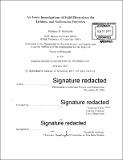| dc.contributor.advisor | Gerbrand Ceder | en_US |
| dc.contributor.author | Richards, William D. (William Davidson) | en_US |
| dc.contributor.other | Massachusetts Institute of Technology. Department of Materials Science and Engineering. | en_US |
| dc.date.accessioned | 2017-05-11T19:58:19Z | |
| dc.date.available | 2017-05-11T19:58:19Z | |
| dc.date.copyright | 2017 | en_US |
| dc.date.issued | 2017 | en_US |
| dc.identifier.uri | http://hdl.handle.net/1721.1/108967 | |
| dc.description | Thesis: Ph. D., Massachusetts Institute of Technology, Department of Materials Science and Engineering, 2017. | en_US |
| dc.description | Cataloged from PDF version of thesis. | en_US |
| dc.description | Includes bibliographical references (pages 119-127). | en_US |
| dc.description.abstract | Solid-state electrolytes have the potential to dramatically improve the safety and longevity of state-of-the-art battery technology by replacing the flammable organic electrolytes currently employed in Li-ion batteries. Recent advances in the development of new thiophosphate electrolytes have reenergized the field by achieving room temperature conductivities exceeding those liquid electrolytes, but a number of practical challenges to their widespread adoption still exist. This thesis applies ab initio computational methods based on density functional theory to investigate the structural origins of high conductivity in ionic conductor materials and provides a thermodynamic explanation of why the integration of these newly developed thiophosphates into high-rate cells has proven difficult in practice, often resulting in high interfacial resistance. As a result of these computational investigations, we report the prediction and synthesis of a new high performance sodium-ion conducting material: NaioSnP 2S 12, with room temperature ionic conductivity of 0.4 mS cm-1, which rivals the conductivity of the best sodium sulfide solid electrolytes to date. We computationally investigate the variants of this compound where Sn is substituted by Ge or Si and find that the latter may achieve even higher conductivity. We then investigate the relationship between anion packing and ionic transport in fast Li-ion conductors, finding that a bcc-like anion framework is desirable for achieving high ionic conductivity, and that this anion arrangement is present in a disproportionately high number of known Li-conducting materials, including Na10SnP2S12 and its structural analog Li10GeP2S2 . Using this bcc anion lattice as a screening criterion, we show that the I4 material LiZnPS4 also contains such a framework and has the potential for very high ionic conductivity. While the stoichiometric material has poor ionic conductivity, engineering of its composition to introduce interstitial lithium defects is able to exploit the low migration barrier of the bcc anion structure. Thermodynamic calculations predict a solid-solution regime in this system that extends to x = 0.5 in Li1+2xZn-xPS 4 , thus it may yield a new ionic conductor with exceptionally high lithium-ion conductivity, potentially exceeding 50 mS cm- 1 at room temperature. Finally, we develop a computational methodology to examine the thermodynamics of formation of resistive interfacial phases through mixing of the electrode and electrolyte. The results of the thermodynamic model of interfacial phase formation are well correlated with experimental observations and battery performance, and predict that thiophosphate electrolytes have especially high reactivity with high voltage oxide cathodes and a narrow electrochemical stability window. We also find that a number of known electrolytes are not inherently stable, but react in situ with the electrode to form passivating but ionically conducting barrier layers. | en_US |
| dc.description.statementofresponsibility | by William D. Richards. | en_US |
| dc.format.extent | 160 pages | en_US |
| dc.language.iso | eng | en_US |
| dc.publisher | Massachusetts Institute of Technology | en_US |
| dc.rights | MIT theses are protected by copyright. They may be viewed, downloaded, or printed from this source but further reproduction or distribution in any format is prohibited without written permission. | en_US |
| dc.rights.uri | http://dspace.mit.edu/handle/1721.1/7582 | en_US |
| dc.subject | Materials Science and Engineering. | en_US |
| dc.title | Ab initio investigations of solid electrolytes for lithium- and Sodium-ion batteries | en_US |
| dc.type | Thesis | en_US |
| dc.description.degree | Ph. D. | en_US |
| dc.contributor.department | Massachusetts Institute of Technology. Department of Materials Science and Engineering | |
| dc.identifier.oclc | 986492266 | en_US |
